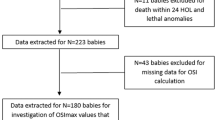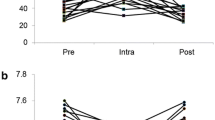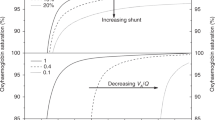Abstract
Arterial blood gases were measured preoperatively and postoperatively in 20 newborn infants with congenital diaphragmatic hernia during spontaneous breathing or assisted ventilation. Of these 20 patients, 11 survived and 9 died. Arterial blood Pco2 levels of survivors (mean of 44.3 ± 7.9 mm Hg) were significantly lower (p <0.01) than those of nonsurvivors (mean of 61.3±15.4 mm Hg). Arterial blood Po2 levels of survivors (mean of 307.9+142.3) were very significantly higher (p<0.001) than those of nonsurvivors (mean of 49.8±14.2). All but 2 survivors had Po2 levels greater than 230 mm Hg in the preoperative period during breathing of 100% oxygen, while none of those who died had Po2 levels higher than 80 mm Hg.
From these results, it is concluded that the prognosis is excellent if the arterial blood Po2 and Pco2 levels are normal preoperatively, or if they can be brought into an acceptable range (Po2 above 230 mm Hg, Pco2 below 70 mm Hg) with oxygen therapy and/or assisted ventilation. On the other hand, if arterial Po2 cannot be raised to the acceptable level by respiratory therapy, a fatal outcome should be anticipated.
Résumé
Des gazométries sanguines artérielles ont été pratiquées avant et après l'opération chez 20 nouveauxnés atteints de hernie diaphragmatique congénitale. Les enfants respiraient spontanément ou étaient soumis à une ventilation assistée. Il y eut 11 survivants et 9 décès. La PaCO2 des survivants était significativement plus basse (moyenne 44.3 ± 7.9 mmHg) que celle des enfants qui succombèrent à l'affection (moyenne 61.3 ± 15.4 mmHG;p < 0.01). La PaO2 était plus élevée chez les survivants (moyenne 307.9 ± 142.3 mmHg) que chez les nourrissons qui moururent (moyenne 49.8 ± 14.2 mmHg:p < 0.001). A l'exception de 2 cas, tous les survivants avaient une PaO2 préopératoire supérieure à 230 mmHg lorsqu'ils respiraient de l'oxygène pur alors qu'aucun des enfants décédés n'avait une PaO2 supérieure à 80 mmHg. On peut donc conclure que le pronostic est excellent si la PaO2 et la PaCO2 preopératoires sont normales ou si elles peuvent être ramenées à des valeurs acceptables (PaO2 supérieure à 230 mmHg et PaCO2 inférieure à 70 mmHg) par administration d'oxygène et/ou par une assistance ventilatoire. D'autre part, si la PaO2 ne peut être remontée à un niveau satisfaisant, il faut s'attendre à une issue fatale.
Similar content being viewed by others
References
Boix-Ochoa, J., Marqués Gubern, A., Peguero, G.: Pronostic des hernies diaphragmatiques sous le rapport de leur équilibre acide-base. Ann. Chir. Infant.13:117, 1972
Boix-Ochoa, J., Peguero, G., Seijo, G., Natal, A., Canals, J.: Acid-base balance and blood gases in prognosis and therapy of congenital diaphragmatic hernia. J. Pediatr. Surg.9:49, 1974
Siggaard-Andersen, O., Engel, K., Jorgensen, K.: A micro method for determination of pH, carbon dioxide tension, base excess and standard bicarbonate in capillary blood. Scand. J. Clin. Lab. Invest.12:172, 1960
Severinghaus, J.W.: Blood gas calculator. J. Appl. Physiol.21:108, 1966
Nelson, N.M.: Neonatal pulmonary function. Pediatr. Clin. N. Am.13:769, 1966
Murdock, A.I., Burrington, J.B., Swyer, P.R.: Alveolar to arterial oxygen tension difference and venous admixture in newly born infants with congenital diaphragmatic herniation through the foramen of Bockdaleck. Biol. Neonate17:161, 1971
Rowe, M.I., Uribe, F.L.: Diaphragmatic hernia in the newborn infant: blood gas and pH considerations. Surgery70:758, 1971
Raphaely, R.C., Downes, J.J.: Congenital diaphragmatic hernia: prediction of survival. J. Pediatr. Surg.8:815, 1973
Reale, F.R., Esterly, J.R.: Pulmonary hypoplasia and pulmonary histology. Pediatrics51:91, 1973
Author information
Authors and Affiliations
Rights and permissions
About this article
Cite this article
Boix-Ochoa, J., Natal, A., Canals, J. et al. The important influence of arterial blood gases on the prognosis of congenital diaphragmatic hernia. World J. Surg. 1, 783–787 (1977). https://doi.org/10.1007/BF01555942
Issue Date:
DOI: https://doi.org/10.1007/BF01555942




